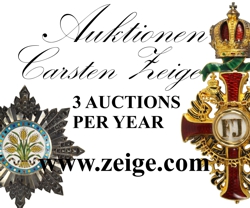Royal Order of Merit of St. Michael, Grand Cross
CATEGORY: Version
SKU: 01.BAV.0102.201.01.000
Estimated market value:





Estimated market value:
The grand cross in the form of a gold cross pattée with blue enamels and lightning bolts emanating from the centre; hollow; the obverse with a solid gold disc depicting St. Michael slaying a dragon - his shield reads “Quis Ut Deus” (Who [is] like God?); the reverse inscribed “Virtuti” (Virtue); suspended from a swivel crown suspension, with a horizontally pierced ball and loop for suspension; measuring 65x111mm; weighing 58.6 grams; with its full-size period original 100 mm wide ribbon; superb quality examples in virtually mint condition.
Elector Joseph Clemens, Archbishop of Cologne and Duke of Bavaria, built a chapel in the Hofmark Berg am Laim near Munich in honour of the Archangel Michael and founded a brotherhood, which was open to everyone. In 1732, the brotherhood had 100,000 members in 53 different locations.
The Knightly Order of St. Michael was instituted on September 29, 1693 by Clemens and could only be conferred upon the Catholic nobility. The order was created to represent the defence and protection of divine honour and the promotion of all that contributes to the glory of God.
Originally, the order consisted of a Grand Master, Grand Cross, and Knight. It was customary to wear a breast star with the cross of the order.
In 1808, King Max Joseph approved the continuation of the order in the Kingdom of Bavaria, and the Commander Cross was added to the order. The Grand Master was selected from the princes of Bavaria. In 1813, the order received the official name of Knightly House Order of St. Michael. From 1693 to 1837, 289 Grand Crosses and 119 Knights Crosses were awarded. The Knightly Order of St. Michael consisted of a Collar, Grand Cross, Grand Cross Breast Star, Knight’s Cross, and Honour Knight’s Cross.
On January 18, 1837, King Ludwig I changed the order name to the Order of Merit of St. Michael. The appearance of the order was also changed and it was determined that the old version of the order should no longer be awarded. Knights who had been previously awarded the old version of the order were permitted to still wear them.
The order could be awarded to all individuals regardless of faith or class. The award was conferred in recognition of loyalty, patriotism, and meritorious service in various fields.
On June 24, 1855, Maximilian II extended the order to include the grade of Grand Commander and divided the Knight’s Cross into I and II Class.The order underwent a further reorganisation in 1887, and by 1910 it consisted of a Grand Cross and corresponding Breast Star, Commander Cross, I Class Cross and I Class Breast Star, II Class Cross and II Class Breast Star, I Class Knight's Cross, II Class Knight’s Cross, III Class Cross, IV Class Cross, Honour Cross, Merit Cross, Silver Medal, and Bronze Medal.
The inscription, “PIETAS FIDELITAS FORTITUDO PERSEVERANTIA”, translates to "Piety, Fidelity, Fortitude, Perseverance”.
The Order was awarded until the abolition of the monarchy on November 7, 1918.

Comments
Sign in to comment and reply.


Scroll Top